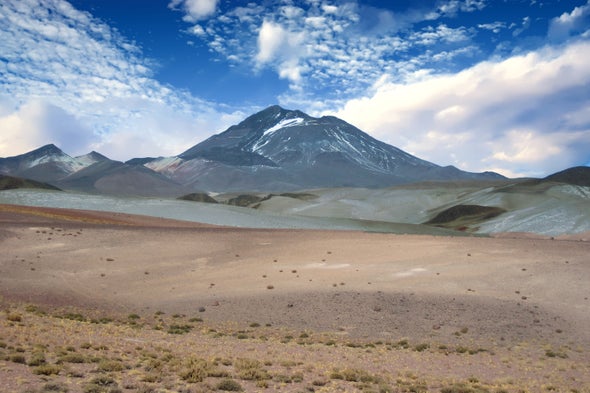This is Scientific American's 60-second Science, I'm Julia Rosen.
In 2013 two mountaineers were nearing the top of Volcán Llullaillaco, a 22,000-foot-tall volcano on the border of Chile and Argentina—when they saw something unexpected. Just 2,000 feet below the summit, the climbers spotted a mouse scurrying across the snow.
"It's really a remarkable sighting, because no one expected wild mammals to be living at an elevation of over 20,000 feet. At that elevation, the scarcity of oxygen makes it really a challenging place to survive and function. But also, the extreme cold. It's an extremely inhospitable environment."
Jay Storz, an evolutionary biologist at the University of Nebraska. The climbers reached out to Storz because he studies how animals adapt to high altitudes. And he was so intrigued that he decided to make his own trip to survey the area.
Storz and his colleagues spent a month at Llullaillaco earlier this year, where they confirmed what the climbers saw. They found mice everywhere, including on the summit—officially setting a new record for the world's highest-dwelling mammal.
Storz says the summit sighting was fortuitous. His climber partner, Mario Pérez Mamani, saw the mouse dive under a rock just as Storz made it to the top, exhausted and groggy from the thin air. It took Storz a minute to gather his wits, but he eventually managed to catch the mouse with his hands. Storz collected that mouse and others as museum specimens that will enable future scientific analysis.
They also recorded their encounter on video. The report is in the Proceedings of the National Academy of Sciences.

Now that he's home, Storz wants to understand how these mice can survive in such harsh conditions and, conversely, what prevents other animals from venturing so high.
"Clearly, the mice that are living at these extreme altitudes have physiological capacities that are very different from your typical rodent."
He and his colleagues are comparing the genomes of the mice from Llullaillaco to their lowland relatives to see if they can identify the animal's high-altitude adaptations. He's curious whether they have evolved some of the same strategies as mice that live at high elevations in North America and the Himalayas.
Storz also wants to know how mice are finding food on top of a barren, rocky volcano, thousands of feet above the highest green plants. On his next trip, he plans to analyze the stomach contents of the animals they capture.
"It's really an open question whether most species—whether their elevational limit is set by physiological tolerance or just the lack of ecological opportunity. It's probably a combination of both."
Whatever the answer, Storz suspects there may be more high-altitude animals out there than scientists thought. It's just a matter of climbing high enough to find them.
Thanks for listening for Scientific American's 60-second Science, I'm Julia Rosen.











